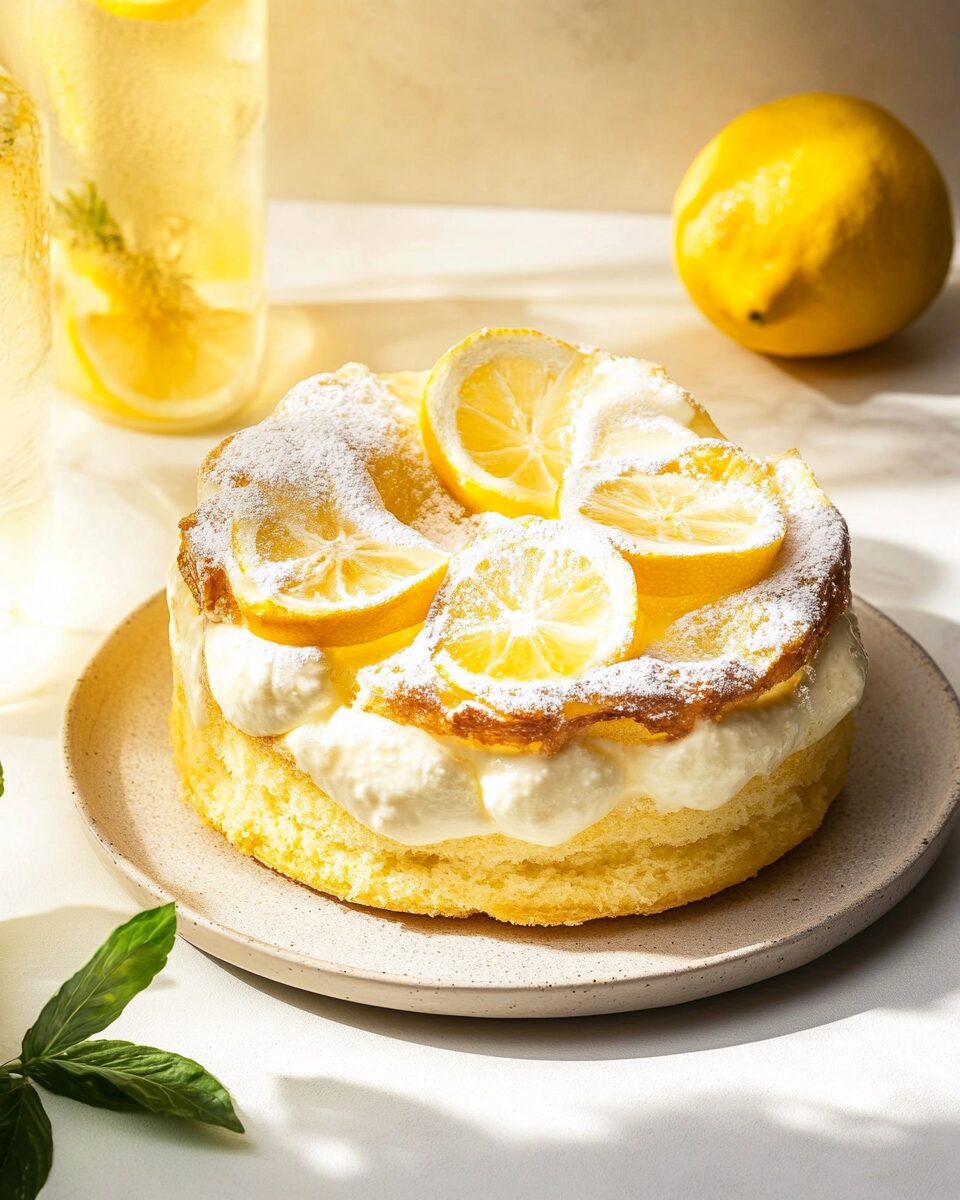Karpatka cake is a traditional Polish dessert featuring two layers of crispy pastry, filled with a rich, smooth custard that melts in your mouth. It’s the perfect balance of textures, with the flakiness of the pastry and the creamy softness of the custard filling.
This dessert is a showstopper for any occasion. Whether it’s served during the holidays, a family gathering, or just a cozy weekend treat, Karpatka cake is sure to impress. It’s the kind of dessert that invites you to take a second slice, and maybe even a third!
Full Recipe:
- 1 cup all-purpose flour
- 1/2 cup butter
- 1/2 cup water
- 1 tablespoon sugar
- 2 eggs
- 1/4 teaspoon salt
- 1 cup milk
- 3 tablespoons cornstarch
- 1/2 cup sugar
- 1 teaspoon vanilla extract
- 1 tablespoon butter (for custard)
Directions:
- Preheat the oven to 350°F (175°C).
- In a saucepan, melt butter in water over medium heat. Once melted, add flour, stir well to create a dough. Allow to cool slightly.
- Beat eggs in a bowl, add them to the dough, stirring vigorously to form a smooth mixture.
- Transfer the dough onto a parchment paper-lined baking tray, spreading it evenly. Bake for 20 minutes or until lightly golden.
- Meanwhile, prepare the custard: in a saucepan, combine milk, sugar, cornstarch, and a pinch of salt. Heat on medium, stirring constantly until thickened.
- Remove from heat and add vanilla extract and butter, mixing until smooth.
- Once the pastry is cool, split it in half and spread the custard over the first layer. Place the second layer on top.
- Refrigerate for a few hours to allow the custard to set.
- Serve chilled, dusted with powdered sugar.
Prep Time: 30 minutes | Cooking Time: 30 minutes | Total Time: 1 hour
Kcal: 290 kcal | Servings: 8 servings
Karpatka Cake: A Decadent Polish Delight
Karpatka, a traditional Polish dessert, takes its name from the Carpathian Mountains, which the cake’s unevenly puffed layers of choux pastry are meant to represent. This delicious and visually striking cake consists of two layers of golden choux pastry filled with a rich, velvety pastry cream, making it an ideal dessert for various occasions, from family gatherings to festive celebrations.
The distinctive features of Karpatka are the irregularly puffed-up layers that mimic the rugged terrain of the Carpathian mountains. While the cake may appear complicated at first glance due to its multi-step process, with proper preparation and patience, it is relatively easy to create this showstopper at home.
Origins and History of Karpatka
Karpatka is a Polish dessert with deep roots in the country’s culinary traditions. The cake’s origin can be traced back to the Carpathian Mountains, hence its name. Over time, it became a beloved treat not only in Poland but in neighboring countries as well. The rustic, uneven appearance of the pastry layers is a characteristic feature of the cake, and it is often dusted with powdered sugar to enhance its rustic charm.
Historically, choux pastry (the foundation of Karpatka) has been a staple in European pastry-making. Its versatility has allowed it to be used in a variety of desserts, from éclairs to profiteroles. The creation of Karpatka involved layering this delicate, puffed pastry with pastry cream, which gives it its signature smooth texture and rich flavor.
Why Karpatka is Loved
The allure of Karpatka lies in its perfect combination of flavors and textures. The crispy and airy choux pastry contrasts beautifully with the rich, smooth, and slightly sweet pastry cream filling. The pastry itself, despite its complexity, is incredibly satisfying, offering a light crunch on the outside while remaining soft and pillowy on the inside. This balance between texture and flavor is what makes Karpatka such a popular dessert.
One of the most appealing aspects of this cake is that it can be made ahead of time, making it perfect for busy holiday preparations or a spontaneous sweet craving. It can be stored in the fridge for up to three days, which only helps the flavors to develop further. The cake’s sturdiness makes it an ideal choice for transporting to gatherings and parties.
The Key Elements of Karpatka
- Choux Pastry: Choux pastry is the essential base of Karpatka. It’s the same dough used for making éclairs, profiteroles, and other cream-filled pastries. The beauty of choux pastry lies in its ability to puff up when baked, creating a light, airy texture that forms the perfect structure for the filling.
In the case of Karpatka, the dough is spread unevenly across the baking pan to create the characteristic mountain-like peaks and valleys. This uneven baking gives the cake its signature look, with some parts puffing up more than others, mimicking the rough terrain of the Carpathian Mountains.
- Pastry Cream (Mousseline Cream): The rich, creamy filling is the heart of Karpatka. The filling is made by first preparing a traditional pastry cream, then whipping it into a mousseline cream by incorporating butter. This creates a silky-smooth, slightly dense cream that balances out the crispy choux layers.
The pastry cream is made by cooking a mixture of milk, sugar, cornstarch, and egg yolks until it thickens into a pudding-like consistency. Once cooled, it is combined with butter, creating a light, smooth filling that complements the choux pastry perfectly.
- Assembly and Presentation: Karpatka is assembled by layering one of the puffed pastry sheets with a generous amount of the pastry cream and then topping it with the second pastry sheet. The uneven layers of the choux create a visually appealing mountain-like structure, and once the cake is chilled, it is dusted with powdered sugar, which adds a touch of elegance and sweetness to the final presentation.
Tips for Perfect Karpatka
Although Karpatka is a straightforward dessert, there are some key tips to keep in mind to ensure the best results:
- Properly Measure Ingredients: For baking success, it’s crucial to measure ingredients accurately. Using a kitchen scale will ensure that you get the correct amounts of flour, butter, and sugar, which can make a big difference in the texture and taste of the final product.
- Prepare Ahead: While Karpatka may seem like a labor-intensive dessert, it can be broken down into manageable steps. Preparing the pastry cream the night before and allowing it to cool to room temperature before mixing with the butter can save you time the next day.
- Temperature Control: One of the trickiest parts of making Karpatka is ensuring the pastry cream and butter are at the right temperatures when combined. If the pastry cream is too warm, it can melt the butter, leading to a runny filling. If the cream is too cold, the butter will solidify too quickly, resulting in a lumpy, grainy texture. Make sure both the pastry cream and butter are at room temperature for smooth incorporation.
- Chill the Cake: After assembling the cake, it’s important to refrigerate it for at least 2 to 3 hours. This allows the pastry cream to set and the layers to firm up, making it easier to slice and serve.
- Bake at the Right Temperature: The choux pastry layers need to be baked until they are golden brown. Avoid opening the oven door during the first 15 minutes of baking, as this can cause the pastry to collapse. Be patient, and let the pastry rise and bake to a deep golden brown.
Variations and Substitutions
While the traditional Karpatka recipe is rich and indulgent, there are some ways you can tweak the recipe to suit your preferences:
- Vegan Karpatka: You can substitute the butter and eggs in the choux pastry and pastry cream with plant-based alternatives. Use vegan butter and a non-dairy milk such as almond or soy milk for a vegan-friendly version of this dessert.
- Flavored Cream: While the traditional Karpatka uses a simple vanilla pastry cream, you can infuse the cream with other flavors, such as coffee or hazelnut, for a unique twist on this classic.
- Fruit Addition: To add a fresh element to Karpatka, consider adding layers of fresh berries or fruit between the choux pastry and the cream filling.
Storing Karpatka
Karpatka should be stored in the refrigerator due to the creamy filling. It will stay fresh for up to 3 days, making it a great dessert to prepare in advance for a party or family gathering. However, it is not recommended to freeze Karpatka, as the cream filling does not freeze well.
Conclusion: A Beautiful Polish Masterpiece
Karpatka is a stunning dessert that showcases the art of Polish baking. With its two layers of crisp choux pastry and rich, buttery pastry cream, it is a treat that both pleases the palate and makes an impression on the eyes. Whether you’re making it for a special occasion or as a weekend treat, Karpatka is sure to impress your guests with its elegant presentation and delightful flavors.
The process may seem a bit daunting at first, but with a little patience and the right techniques, you can recreate this iconic Polish dessert at home. Once you’ve mastered the basics of choux pastry and pastry cream, you can experiment with variations and make Karpatka your own.





